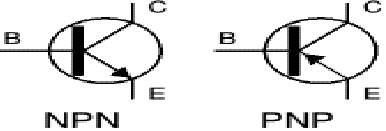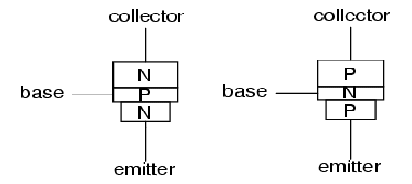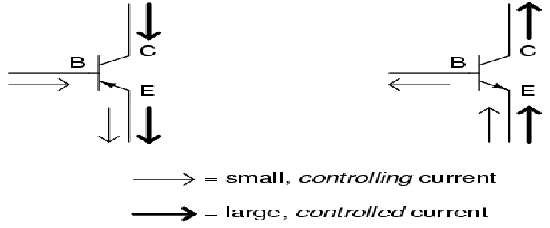Invented in 1948, the transistor is basically an electronic switch. They are used to amplify or switch electronic signals. A transistor is made of a solid piece of a semiconductor material, with at least three terminals for connection to an external circuit. A voltage or current applied to one pair of the transistor's terminals changes the current flowing through another pair of terminals. Because the controlled (output) power can be much more than the controlling (input) power, the transistor provides amplification of a signal. Some transistors are packaged individually but most are found in integrated circuits. They can be made so tiny that millions can now be packed onto the compact electronic chips that are the brains of modern computers. Before the transistor, the only comparable device was the large, unreliable and power hungry vacuum tube.
There are two types of standard transistors, NPN and PNP, with different circuit symbols. The letters refer to the layers of semiconductor material used to make the transistor. Most transistors used today are NPN type because this is the easiest of the two to make.

The leads are labelled base (B), collector (C) and emitter (E).


For each type, a small current between the base and emitter can control a much larger current between the collector and emitter terminals.
If there is no current through the base of the transistor, it shuts off like an open switch and prevents current through the collector. If there is a base current, then the transistor turns on like a closed switch and allows a current through the collector.
SUMMARY:
-
Bipolar transistors are so named because the controlled current must go through two types of semiconductor material: P and N. The current consists of both electron and hole flow, in different parts of the transistor.
-
Bipolar transistors consist of either a P-N-P or an N-P-N semiconductor "sandwich" structure.
-
The three leads of a bipolar transistor are called the Emitter, Base, and Collector.
-
Transistors function as current regulators by allowing a small current to control a larger current. The amount of current allowed between collector and emitter is primarily determined by the amount of current moving between base and emitter.
-
In order for a transistor to properly function as a current regulator, the controlling (base) current and the controlled (collector) currents must be going in the proper directions: meshing additively at the emitter and going against the emitter arrow symbol.